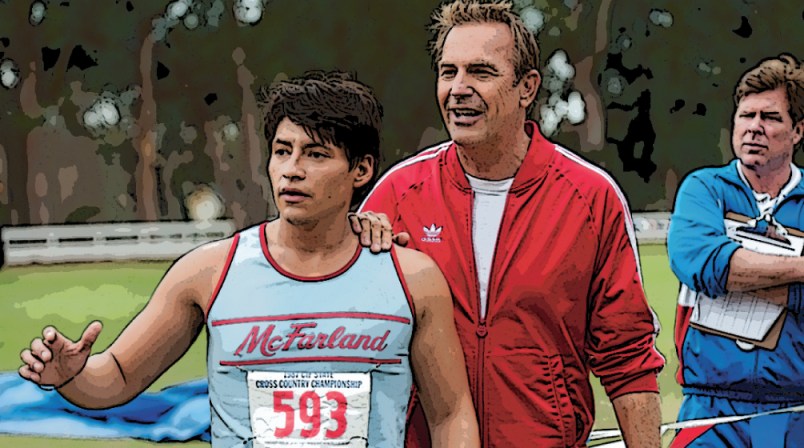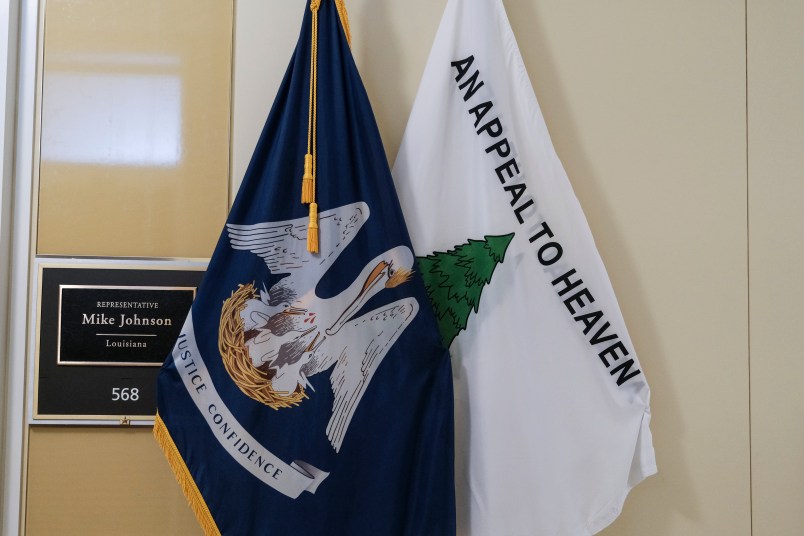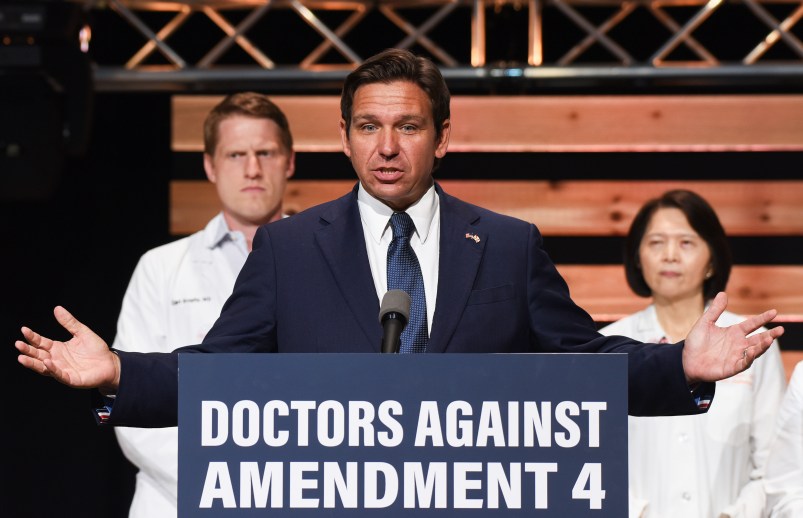The first time I saw it, I got chills and my eyes watered. Maybe it was the rose-colored quality of most Disney movies, or the musical score that swelled dramatically during each touching moment. More likely, the two-minute trailer for McFarland, USA, which hit theaters last month, affected me on such a visceral level because of the Mexican characters.
As a Mexican American myself, seeing people who look like me onscreen is not as common as it ought to be. Add that to the fact that I ran cross country in high school and my mom toiled as a farm worker as a teenager, and it’s no wonder the storyline resonated so deeply. Set in the California town of McFarland, the movie tells the story of a team of Mexican-American cross-country runners who are led by a white coach (named, fittingly, Jim White) in their pursuit of a state championship. The young men in the film are also farm workers and struggle to balance familial, school and cross-country obligations in a poignant tale that touches on race and the plight of many Mexican Americans in this country.
The film’s white director, Niki Caro, said in a February interview with The Credits that “[w]e were very conscious of not making a white savior movie…it was really important for us that he be a flawed guy who was ultimately redeemed by the community.”
Caro did a fine job of giving the Mexican-American community some depth, and she does refrain from deifying the white coach. But her best efforts can’t undo the fact that this movie is centered around him. The decision to cast the well-known Kevin Costner in the lead role of the white coach made it all but inevitable that this movie would fall squarely within the frame of a white savior movie.
And that’s okay.
They get a bad rap, but when they’re good, WSMs serve important purposes. They provide a lens through which white Americans can see themselves interacting with minorities. They act as all-too-rare showcases for actors of color. And as uncomfortable and enraging as this may be, they’re often historically accurate.
While it’s easy to be scornful of the need for a palatable white conduit, it’s actually a tendency that transcends race. The reality is people—of all races—are naturally better able to identify same-race faces and, from infancy, repeated exposure to same-race faces leads to increased familiarity and a visual preference for faces that look like our own. This preference is also witnessed in the “mere exposure” principle, the human tendency to unduly favor things with which we’re familiar.
This is why people respond in greater numbers when someone of their own race is threatened: We see ourselves, our parents, our siblings, our children. When someone looks like us, there’s an inherent and often subconscious tendency to relate and empathize. Knowing this information is valuable because we can harness white savior movies to work for us rather than against us in a country that is still 64 percent white.
While this “exposure principle” might also work if we bombarded white viewers with trailers full of minorities, there’s no guarantee that white Americans would actually go watch the movie, which doesn’t serve anybody. By appealing to the natural human biases we all possess, we can use the white savior premise to attract white audiences and use the narrative to convey our own, little-seen realities. Actors, and to a greater extent, directors and producers, can control how minorities and whites are portrayed within the narrative to convey the flaws and virtues of both sides while still maintaining the core realness of true stories.
A commitment to accuracy has long been an argument in defense of white savior narratives. And, frankly, it’s a good one. Whites in this country have held more power and enjoyed more economic success and educational gain, in larger numbers and for a longer period of time, than minorities. It’s only natural that those better equipped to give back and elicit positive change would be white.
Just because this historical dynamic is unfair and infuriating doesn’t mean these stories shouldn’t be told. The kindness of the white female lead in The Blind Side shouldn’t be erased because she’s white and the person she’s helping is black. The white journalist in The Soloist who helps a homeless, mentally ill, black violinist shouldn’t be condemned for trying to help a fellow human being. Yes, some of these movies could be more self-aware about this dynamic—a little meta-recognition in the dialogue, perhaps, or awkward-but-necessary scenes that tackle race. But if it’s a compelling true story, there’s no harm in sticking to the facts.
Look, I get it. Recognizing how paternalism has historically worked in America doesn’t tamp down my visceral response when I see people of color portrayed as bumbling idiots, when people who look like me are splashed across screens in unrecognizable ways. I hate the WSMs in which young, bright-eyed white teachers march resolutely into dangerous schools filled with dangerous minorities and show them the power of education. (See the prototype: Dangerous Minds.) Most of us don’t need a white person to tell us about the power of education. We don’t need them to employ tired slang and pander to cultural stereotypes in order to reach us. And we certainly don’t need to see the awe these teachers exhibit when they singlehandedly tap into the intelligence these students didn’t realize they possessed.
There’s a way to sidestep this simplistic, offensive tendency by portraying characters who, irrespective of skin color, are multidimensional and raw. But not all WSMs are created equal. They truly become a problem when the story whitewashes the white character’s flaws, while drawing attention to the desperation of the minority victims.
Or worse, when the story is complete fiction.
White savior movies such as Django Unchained, Avatar and even To Kill a Mockingbird can’t wield the excuse of being steeped in reality. Fiction is a natural realm of progress when it comes to characters of color. Unbound by the obligations and restraints of history, storytellers can create their own narratives and cast minorities in the role of hero or savior. Or abandon the model of one central savior entirely. But when writers and producers have a blank canvas and choose to overlook admirable minority figures in history in favor of fictional white characters, it’s indefensible.
Still, even the most egregious white savior plot lines can be subversive for the actors cast in them. The Help was a fictitious fantasy about a young Southern woman spurring a domestic workers movement, but its talented African- American actresses took advantage of the platform. They acted their asses off, overshadowing the female lead, and it served them well: Octavia Spencer, who won an Oscar the next year, has worked steadily since, and Viola Davis now stars in her own network show. Regardless of their plots, these movies shine a spotlight on minority actors and enable them to snag high-profile lead roles—so that they can later star in better movies, whose nonwhite characters empower themselves.
After all, there shouldn’t be a quota on how many stories can be told. Movies like Selma and Cesar Chavez go a long way in exposing the ignorance of the argument that white savior narratives fill a gap that minorities can’t fill themselves. Just like there are the lesser-known white heroes plucked from obscurity for WSMs, there are just as many minorities waiting to highlight the ways in which they prevailed without help from white people.
Yet the fact remains: White savior movies produced by mostly white, mostly male-run studios will continue to be made with or without our input or theater dollars. WSMs have proven to appeal to a wide audience, especially when they have familiar, big-name white actors at the helm. So why not commandeer these white savior narratives in our favor, all the while demanding more?
The Mexican-American characters in McFarland, USA accomplish this brilliantly. They project themselves on the screen with such vivacity and realness that they command your attention away from Costner’s Coach White and usurp the authority that was bestowed upon him. The coach might be the lens through which we initially view the minority characters. But before long, these kids manage to determine their own boundaries, communing with the viewer without the white filter.











Friday Night Lights --a White Savior TV show is GREAT television.
Breaking Bad–a White Demonic TV show–is even better.
Does mean the “Magic Negro” genre is dead?
Well, this essay will revive the reputation of the original White Savior Movie: Birth of A Nation.
To Kill a Mockingbird is hardly a “white savior” movie. If anything, it’s the opposite. That genre focuses mostly on white folks who swoop in to help minority kids discover and reach their full potential. Atticus wasn’t doing that. He was fighting a quixotic battle against a racist system and the only people who learned anything were his own kids.
Great essay. It opened up a new way of looking at WSM to me. I was very disappointed in movies like Mississippi Burning. I am uncomfortable with rewriting history to totally airbrush other races out of any narrative. I am more ok with that approach in fiction. Mainly, I agree that any vehicle that gets more opportunities for new faces and talent and that exposes audiences to new perspectives is a good thing.